Featured This Month
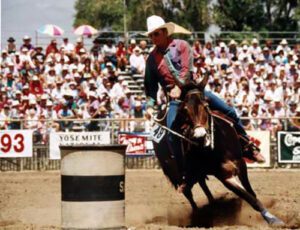
MULE CROSSING: Surge of Mule Shows
All Articles
MULE CROSSING: Showing in Harness
By Meredith Hodges
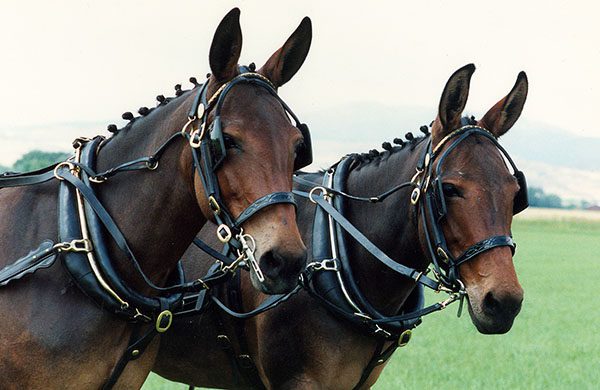 Now that you have spent many months teaching your mule to drive and he is doing so well, you have decided that it might be fun to show him in harness. So, what are that kinds of things that a judge looks for in a driving class of mules? Well, it’s basically the same as it is with horses.
Now that you have spent many months teaching your mule to drive and he is doing so well, you have decided that it might be fun to show him in harness. So, what are that kinds of things that a judge looks for in a driving class of mules? Well, it’s basically the same as it is with horses.
The first and foremost consideration for a judge is your mule’s manners. His manners will exhibit just how safe your mule is for driving. As with people, a judge can get an overall impression from the expression on your mule’s face! An attentive and pleasant expression is definitely preferred. The expression on his face will reflect his overall comfort within a situation. If he is comfortable, he responds to minimal aids calmly, confidently, yet promptly. He should reinback easily upon request, and stand quietly at the halt with all four legs squared. His ears will be relaxed, but attentively turned to the driver most of the time. Ears that are rapidly in motion indicate anxiety and distraction.
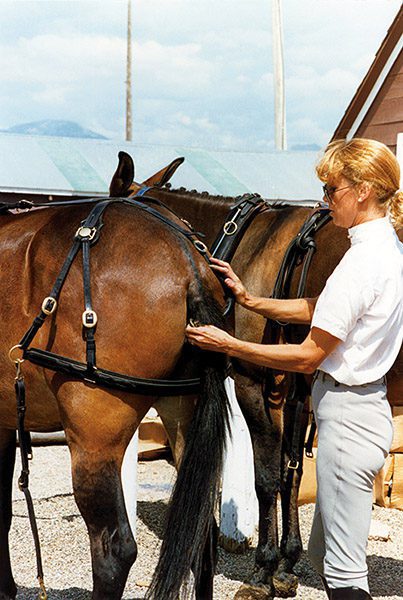 A major contributing factor in your mule’s overall manners is his conditioning. If your mule has been brought along with a carefully planned exercise program, his muscle growth and strength will increase with little or no stress, as it should in most athletes. The mule that is conditioned in this way will have the strength to pull while maintaining a smooth, steady and effortless gait. He is comfortable in his work. Properly conditioned mules will not exhibit the tenseness that comes from overexertion, a tenseness that can inhibit his entire performance.
A major contributing factor in your mule’s overall manners is his conditioning. If your mule has been brought along with a carefully planned exercise program, his muscle growth and strength will increase with little or no stress, as it should in most athletes. The mule that is conditioned in this way will have the strength to pull while maintaining a smooth, steady and effortless gait. He is comfortable in his work. Properly conditioned mules will not exhibit the tenseness that comes from overexertion, a tenseness that can inhibit his entire performance.
How can you tell if your mule is well-conditioned? Touching his body with your fingers at the neck, shoulders, barrel, loins, stifles and rump can tell you a lot. These muscles should be hard and not mushy to the touch. Standing behind your mule, you should begin to see considerable gaskin development. A driving class lasts approximately 20 to 30 minutes. If you condition your mule at the medium trot for 20 minutes straight, without any sweating or breathing hard, he should be able to handle the class with no problem. Another helpful hint is to condition him on uneven ground. Then, when he performs on the flat ground, it will seem a lot easier to him. Remember to condition slowly to avoid overexertion, muscle soreness or injury. If you condition your mule beyond what is expected in the class, you won’t have to worry about him being fit for class! And, as long as he is so well conditioned, be sure he is well-groomed as well.
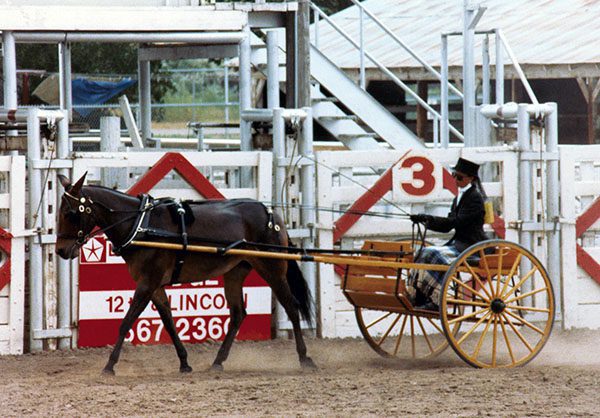 Your mule’s way of going is another important consideration for the judge. In the driving class, your mule will be asked for the walk, collected trot, working trot and the reinback. The walk should be “regular and unconstrained, energetic, but calm with even and determined steps with distinctively marked four equally spaced beats.” In the collected trot, “the neck is raised, thus enabling the shoulders to move with greater ease in all directions, the hocks well-engaged and maintaining energetic impulsion not withstanding the slower movement.” The mule’s steps are shorter, but are lighter and more mobile. The working trot is a pace between the collected and extended trots. The mule “goes forward freely and straight, engaging the hind legs
Your mule’s way of going is another important consideration for the judge. In the driving class, your mule will be asked for the walk, collected trot, working trot and the reinback. The walk should be “regular and unconstrained, energetic, but calm with even and determined steps with distinctively marked four equally spaced beats.” In the collected trot, “the neck is raised, thus enabling the shoulders to move with greater ease in all directions, the hocks well-engaged and maintaining energetic impulsion not withstanding the slower movement.” The mule’s steps are shorter, but are lighter and more mobile. The working trot is a pace between the collected and extended trots. The mule “goes forward freely and straight, engaging the hind legs 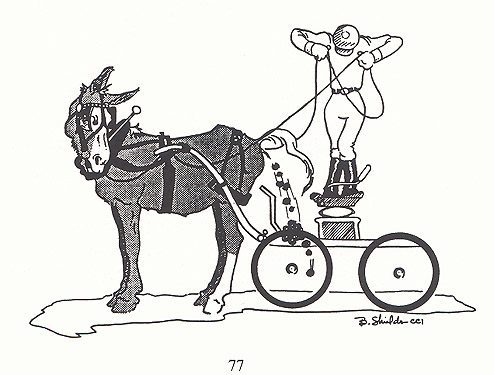 with good hock action, on a taut, but light rein, the position being balanced and unconstrained. The steps are
with good hock action, on a taut, but light rein, the position being balanced and unconstrained. The steps are
even as possible and the hind feet touch the ground in the foot prints of the fore feet.” The reinback is “a kind of walk backwards. The legs being raised and set down simultaneously by diagonal pairs, the hind legs remaining well in line and the legs being well raised.” The mule that is conditioned slowly with special attention given to core strength, straightness, balance and bend will begin to carry himself in good equine posture and exhibit these true gaits naturally after a period of practice time.
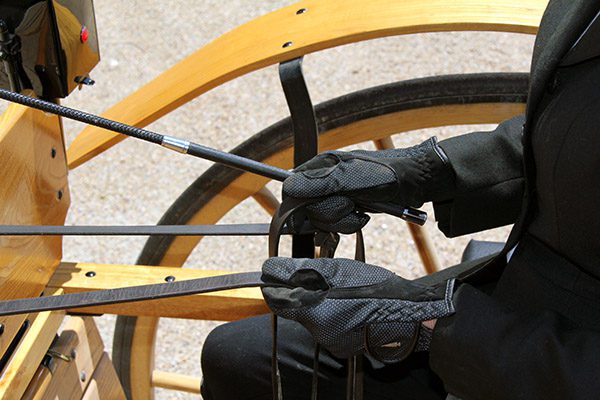 The next consideration is the appropriateness of the animal to the vehicle he is pulling. A smaller mule should never be used to pull a large wagon, nor should the larger draft mule be used to pull a pony cart! Select a vehicle that pulls easily for your mule and one that is proportionate to his size. The overall picture should be balanced and harmonious. Fifty percent of your total class score will include your mule’s manners, his conditioning, his way of going and the appropriateness of the general turnout.
The next consideration is the appropriateness of the animal to the vehicle he is pulling. A smaller mule should never be used to pull a large wagon, nor should the larger draft mule be used to pull a pony cart! Select a vehicle that pulls easily for your mule and one that is proportionate to his size. The overall picture should be balanced and harmonious. Fifty percent of your total class score will include your mule’s manners, his conditioning, his way of going and the appropriateness of the general turnout.
Twenty percent of your total score is judged on you, the whip or teamster. Your hands should be held at waist level, about three inches in front of your body and about 10 inches apart. “A rein passes between the forefinger and middle finger of each hand and is held secure with pressure from the thumb; the whip is held in the right hand.” You should always sit in good posture and the use of your aids should be almost imperceptible. An expert Reinsman rarely exceeds a 12″ imaginary box around his hands. Your dress should be appropriate to the vehicle in which you ride.
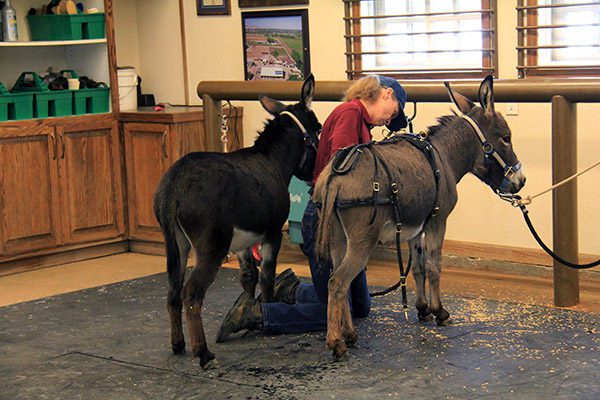 For instance, a formal coach would require a more formal dress than would a two-wheel country cart. Dress must be conservative for the times. Western dress is permitted where appropriate. Hat, gloves, coat, tie, and a lap apron are required. A whip must be held in hand at all times! Always look where you are going, check the judge for instructions periodically and pay attention to spacing in the arena! The remaining considerations for a judge are the vehicle and the harness with each carrying 15% of your total score. The vehicle should be in good repair, appropriate size and style for your mule, and should fit him properly through the shafts and tugs. The harness should fit him as well as possible and should be adjusted correctly, especially the breeching so it can do its job in the reinback.
For instance, a formal coach would require a more formal dress than would a two-wheel country cart. Dress must be conservative for the times. Western dress is permitted where appropriate. Hat, gloves, coat, tie, and a lap apron are required. A whip must be held in hand at all times! Always look where you are going, check the judge for instructions periodically and pay attention to spacing in the arena! The remaining considerations for a judge are the vehicle and the harness with each carrying 15% of your total score. The vehicle should be in good repair, appropriate size and style for your mule, and should fit him properly through the shafts and tugs. The harness should fit him as well as possible and should be adjusted correctly, especially the breeching so it can do its job in the reinback.
Often, it is difficult to find horse harnesses that will fit the lighter and smaller mules or donkeys properly, but you can approximate the size you need (i.e. pony, cob, horse, draft) and then make the necessary adjustments, or 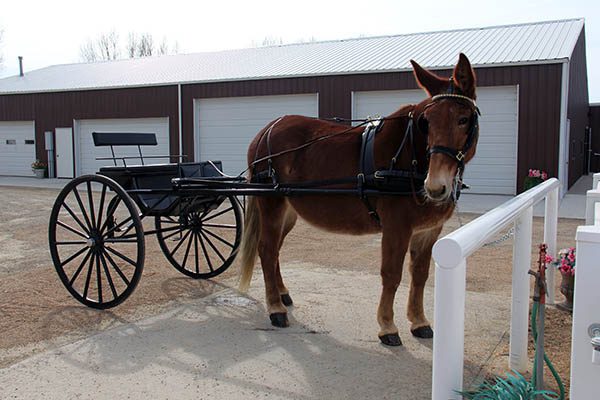 have a professional harness-maker help you. Your mule should be fastened snugly to the vehicle. Be sure that your collar or breast collar fits your mule properly as this can create soreness and make for a very unhappy mule! Adjust the breeching snugly enough to make your “brakes” effective! One of the most common mistakes made by beginning drivers is adjusting the breeching too loose. This makes it difficult for your mule to either slow down or back straight and evenly, and the resulting slack will make his transitions look abrupt and awkward!
have a professional harness-maker help you. Your mule should be fastened snugly to the vehicle. Be sure that your collar or breast collar fits your mule properly as this can create soreness and make for a very unhappy mule! Adjust the breeching snugly enough to make your “brakes” effective! One of the most common mistakes made by beginning drivers is adjusting the breeching too loose. This makes it difficult for your mule to either slow down or back straight and evenly, and the resulting slack will make his transitions look abrupt and awkward!
There is a lot to consider as a driving judge, but judges are also human beings, and basically the judge is going to select those mules for placement in the class that HE would most like to drive. If you follow the guidelines that I have described, your Longears will be one of the judge’s favorites!
To learn more about Meredith Hodges and her comprehensive all-breed equine training program, visit LuckyThreeRanch.com, MEREDITH HODGES PUBLIC FIGURE Facebook page, or call 1-800-816-7566. Check out her children’s website at JasperTheMule.com. Also, find Meredith on Pinterest, Instagram, MeWe, YouTube and Twitter.
© 1991, 2016, 2019, 2021, 2023, 2024 Lucky Three Ranch, Inc. All Rights Reserved.
MULE CROSSING: Jumping Mules
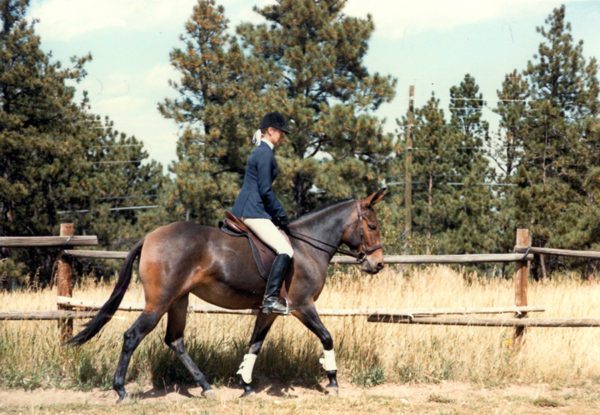 By Meredith Hodges
By Meredith Hodges
In 1986, when I first began using my mules in Dressage, you would never have convinced me that I would follow it up with jumping. I was fearful of jumping because of a few bad experiences I had with horses. However, once I took the time to learn to ride and train properly with Dressage and experienced the overall stability of a mule, my fear disappeared.
Nowadays, when people find out that I jump my mules and my donkeys, the response is often, “I didn’t know mules could jump!” Not only can mules jump, they are quite good at it. However, if a mule, donkey or any other equine is to have the strength and coordination they need for jumping, their training must be approached in a specific, practical and healthy way. Then they can learn to maintain good rhythm in all gaits between jumps, to jump only as high as needed to clear fences, and to adjust their strides to and away from jumps. Proper jumping training takes time and patience because there is much more to jumping than just making it over the fences.
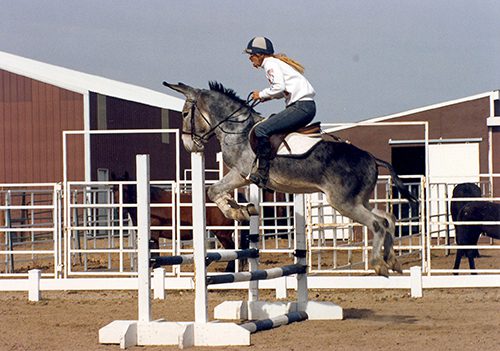 If you speak to mule owners all over the world, you will hear at least one tale in ten about a mule jumping out of his pen. If they have the inclination, most mules have the ability to easily clear a fence up to and even over six feet high. The capability is certainly there, but in general, mules lack the motivation to expend the energy to actually jump out, especially when they are well managed.
If you speak to mule owners all over the world, you will hear at least one tale in ten about a mule jumping out of his pen. If they have the inclination, most mules have the ability to easily clear a fence up to and even over six feet high. The capability is certainly there, but in general, mules lack the motivation to expend the energy to actually jump out, especially when they are well managed.
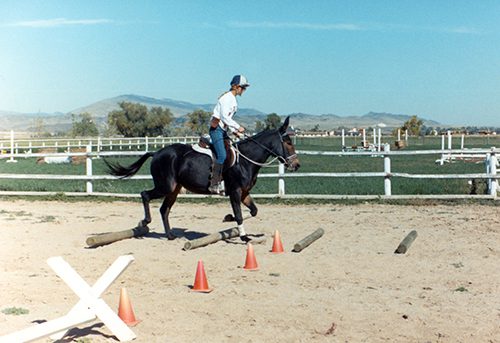 The muscle structure of a mule and donkeys is a bit different than that of a horse—somewhat like the difference between the muscle structure of a ballet dancer and that of a a weight lifter. A mule’s muscle structure (like that of a ballet dancer’s) is comprised of longer, smoother muscle with less bulky areas, a trait inherited from the donkey. This gives him a slightly more streamlined appearance than that of a horse. And like a ballet dancer, a mule can spring his body effortlessly into the air using the muscles in his hindquarters, giving him the ability to jump either from a standstill or while in
The muscle structure of a mule and donkeys is a bit different than that of a horse—somewhat like the difference between the muscle structure of a ballet dancer and that of a a weight lifter. A mule’s muscle structure (like that of a ballet dancer’s) is comprised of longer, smoother muscle with less bulky areas, a trait inherited from the donkey. This gives him a slightly more streamlined appearance than that of a horse. And like a ballet dancer, a mule can spring his body effortlessly into the air using the muscles in his hindquarters, giving him the ability to jump either from a standstill or while in 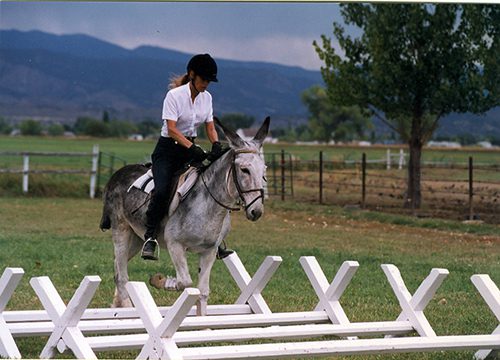 motion. For the weight lifter or the horse, this maneuver is not as easy due to their particular muscle structure. So when selecting a horse for advanced jumping, it is wise to select a breed or type of horse that has less bulk muscle and more smooth muscle, like the mule., and both need the thickness o bone to absorb the concussion on the landings.
motion. For the weight lifter or the horse, this maneuver is not as easy due to their particular muscle structure. So when selecting a horse for advanced jumping, it is wise to select a breed or type of horse that has less bulk muscle and more smooth muscle, like the mule., and both need the thickness o bone to absorb the concussion on the landings.
When riding toward a jump, a donkeys or mule’s approach can often interfere with his coursework because his impulse is usually to gallop to the jump, stop and then spring over the top. Horses, on the other hand, tend to naturally do their coursework more smoothly and in stride. The mule and donkey can learn to jump in stride if given the correct schooling to overcome his instinctive way of going.
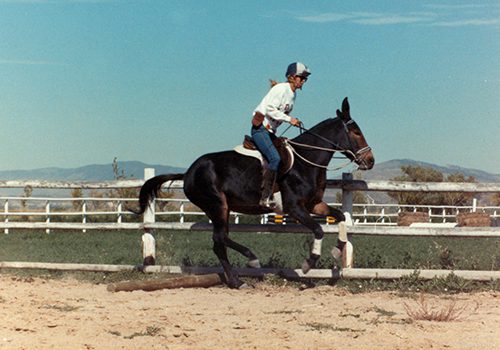 Regardless of the mule’s inherent strength and endurance, in the beginning of jumping training, he will lack the muscle development and stamina required to negotiate a course of jumps effortlessly and in stride. Like any other living creature, he can only strengthen the muscles that he uses, so it is up to you to make sure he is doing specific exercises that pinpoint the correct sets of muscles so he can do his job over the jumps, between the jumps, before and after the jumps.
Regardless of the mule’s inherent strength and endurance, in the beginning of jumping training, he will lack the muscle development and stamina required to negotiate a course of jumps effortlessly and in stride. Like any other living creature, he can only strengthen the muscles that he uses, so it is up to you to make sure he is doing specific exercises that pinpoint the correct sets of muscles so he can do his job over the jumps, between the jumps, before and after the jumps.
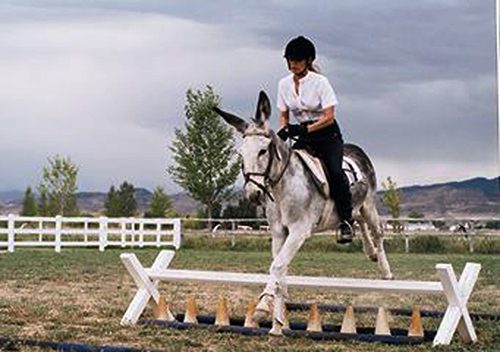 These three tasks require different postures that need to be supported by different muscle groups, so work on training and strengthening the specific exercises as outlined in DVD #7 of my Training Mules and Donkeys series. A proper conditioning program of exercises for your mule ro donkey will strengthen the muscles needed for jumping and will prepare him for a more polished performance. This is also a good opportunity to fine-tune all the muscles in your own body as you fine-tune those of your mule or any other equine.
These three tasks require different postures that need to be supported by different muscle groups, so work on training and strengthening the specific exercises as outlined in DVD #7 of my Training Mules and Donkeys series. A proper conditioning program of exercises for your mule ro donkey will strengthen the muscles needed for jumping and will prepare him for a more polished performance. This is also a good opportunity to fine-tune all the muscles in your own body as you fine-tune those of your mule or any other equine.
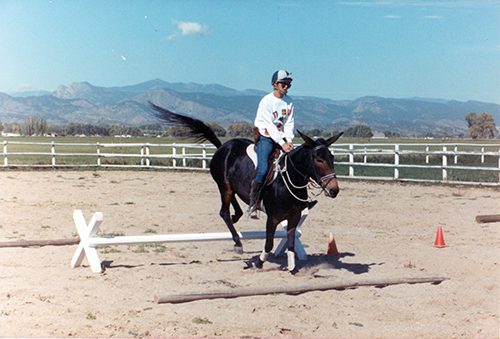 While training your equine to jump, you must ask yourself some very important questions. Does my animal possess the strength of body to carry him from the hindquarters with sufficient impulsion, rhythm and balance? Can he readily lengthen or shorten his stride to accommodate the distance to his fences? Are these adjustments easily made, or does my equine tend to throw his weight onto his forehand during transitions between gaits and over fences? Remember, the animal that is well schooled in jumping will carry his body with ease and make smooth transitions from an uphill balance.
While training your equine to jump, you must ask yourself some very important questions. Does my animal possess the strength of body to carry him from the hindquarters with sufficient impulsion, rhythm and balance? Can he readily lengthen or shorten his stride to accommodate the distance to his fences? Are these adjustments easily made, or does my equine tend to throw his weight onto his forehand during transitions between gaits and over fences? Remember, the animal that is well schooled in jumping will carry his body with ease and make smooth transitions from an uphill balance.
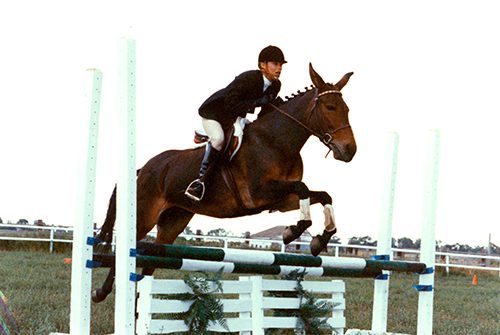 There are a series of exercises that will help to build your prospect into a beautiful, stylish and exciting jumper, but it will take time and patience— there just aren’t any shortcuts. Taking the time and exercising your patience will produce not only an animal that jumps properly, but one that is also strong and confident in his abilities. This can come in mighty handy later on when you find yourself in more demanding jumping situations. Having taught your equine to jump safely, you will have a more pleasurable and stress-free ride.
There are a series of exercises that will help to build your prospect into a beautiful, stylish and exciting jumper, but it will take time and patience— there just aren’t any shortcuts. Taking the time and exercising your patience will produce not only an animal that jumps properly, but one that is also strong and confident in his abilities. This can come in mighty handy later on when you find yourself in more demanding jumping situations. Having taught your equine to jump safely, you will have a more pleasurable and stress-free ride.
When initially riding a mule over jumps, you will notice the slightly “different” way that he feels in action, compared to a horse. If you are used to jumping horses, this may seem a little odd at first but you will soon find that the mule feels 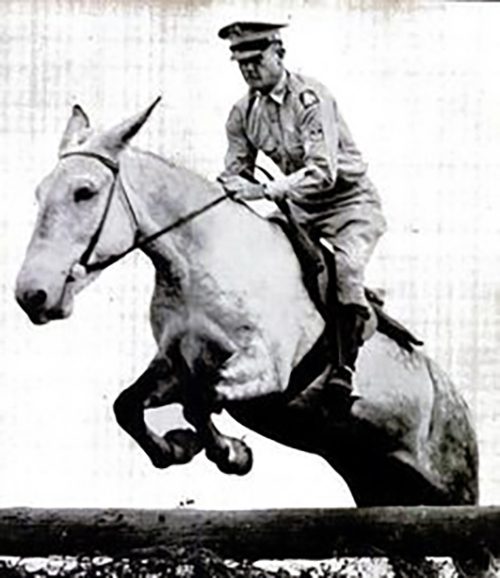 more sure and stable. To me, a mule seems more balanced and stronger throughout than does a horse, and so the chance of taking a misstep or crashing a jump is lessened. Should a loss of balance or error occur, the mule is usually able to more quickly recover than the horse, making for a safer ride.
more sure and stable. To me, a mule seems more balanced and stronger throughout than does a horse, and so the chance of taking a misstep or crashing a jump is lessened. Should a loss of balance or error occur, the mule is usually able to more quickly recover than the horse, making for a safer ride.
For those of you who still don’t believe that mules can really jump, all I can say is, believe it! More than a few retired cavalry officers have personally told me about Hambone, the infamous jumping mule from Fort Carson, Colorado. They’ve also told me about jumping their mules Roman-style, which means standing with one foot on the rear end of each of a pair of mules while doing patterns and jumping obstacles!
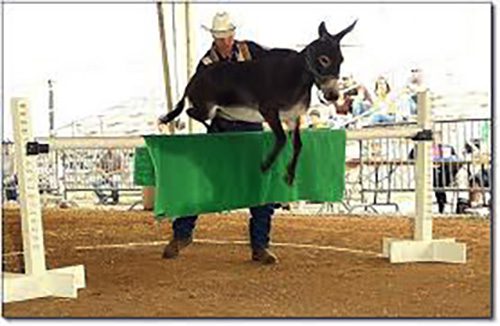 Today, mules are jumped in all kinds of events, from Combined Training to Hunter/Jumper classes. Jumping mules adds excitement and variety to training events and events where mules jump in competition under saddle against each other, and even against horses. Coon hunters often display the mule’s natural ability to jump from a standstill by jumping them in-hand over fences, either on hunts or at shows, and some mule owners even try their luck at Fox Hunting.
Today, mules are jumped in all kinds of events, from Combined Training to Hunter/Jumper classes. Jumping mules adds excitement and variety to training events and events where mules jump in competition under saddle against each other, and even against horses. Coon hunters often display the mule’s natural ability to jump from a standstill by jumping them in-hand over fences, either on hunts or at shows, and some mule owners even try their luck at Fox Hunting.
When mules are actually being used for coon hunting, they are typically smaller mules that can be ridden. When 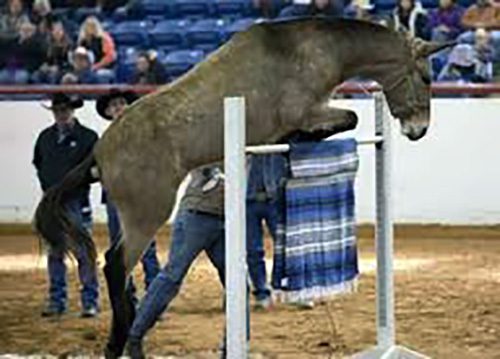 they come to a fence, most of which are barbed wire, the hunter will take the blanket, lay it over the fence for safety’s sake and thengo to the other side of the fence and ask the mule to jump it. When this is a class at a show, it is staged very much the same way, but you will see more larger mules on display. By any standards, the mule’s capacity to jump is unquestionable, and there is no doubt he will continue to climb the ladder of equine success. The mule will often exceed people’s expectations, but in most cases he will out-perform his horse counterparts. Hambone proved this to be true when he jumped so well, won against the competition and got mules banned from competing against the horses again!
they come to a fence, most of which are barbed wire, the hunter will take the blanket, lay it over the fence for safety’s sake and thengo to the other side of the fence and ask the mule to jump it. When this is a class at a show, it is staged very much the same way, but you will see more larger mules on display. By any standards, the mule’s capacity to jump is unquestionable, and there is no doubt he will continue to climb the ladder of equine success. The mule will often exceed people’s expectations, but in most cases he will out-perform his horse counterparts. Hambone proved this to be true when he jumped so well, won against the competition and got mules banned from competing against the horses again!
To learn more about Meredith Hodges and her comprehensive all-breed equine training program, visit LuckyThreeRanch.com, MEREDITH HODGES PUBLIC FIGURE Facebook page, or call 1-800-816-7566. Check out her children’s website at JasperTheMule.com. Also, find Meredith on Pinterest, Instagram, MeWe, YouTube and Twitter.
© 2016, 2017, 2022, 2023, 2024 Lucky Three Ranch, Inc. All Rights Reserved.
MULE CROSSING: Hauling Long Distances
By Meredith Hodges
Hauling long distances needn’t be a problem with your Longears, if you use a little common sense and consideration. Their natural durability and good sense make them basically easier to haul than horses. When hauling for more than four or five hours, there are a few things to consider. Be sure to have your Health Papers and recent Coggins tests done for the trip. You will need them to cross state lines. If you need to carry firearms with you, be sure to look into the state laws for legal carrying. Make sure to have full insurance coverage on your truck and trailer and on miscellaneous items that you would be carrying like tack, equipment and camping gear. There are separate temporary policies you can get for those kinds of things. Insuring the equines themselves is often very expensive and they don’t tend to pay if something happens. Always carry a First Aid kit and tools to fix simple problems you might have with your truck and trailer, and know how to use them.
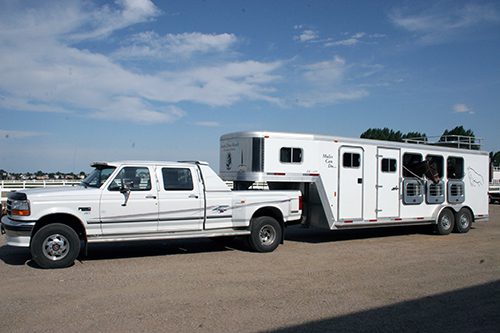 First, you should be sure that the trailer in which they are to ride affords safety and comfort and that the plates on both the truck and trailer are up-to-date. Before you leave, you should check over your trailer thoroughly. Make sure the hitch is secure and in good repair, and that there are no weakened welds anywhere. Check your trailer’s tires, bearings, axels and brakes for maximum performance, and make sure all the lights are in working order. Take the trailer mats out and check the floor boards for rot and other weaknesses, and replace all floor boards that are even questionable. It is always good practice to get all new tires for the trip and a new spare.
First, you should be sure that the trailer in which they are to ride affords safety and comfort and that the plates on both the truck and trailer are up-to-date. Before you leave, you should check over your trailer thoroughly. Make sure the hitch is secure and in good repair, and that there are no weakened welds anywhere. Check your trailer’s tires, bearings, axels and brakes for maximum performance, and make sure all the lights are in working order. Take the trailer mats out and check the floor boards for rot and other weaknesses, and replace all floor boards that are even questionable. It is always good practice to get all new tires for the trip and a new spare.
Using bedding such as shavings or straw in the trailer may afford a little extra comfort, and can encourage urination on the trip, but it isn’t always the best thing to do. The wind can cause the bedding to fly around inside the trailer, causing irritation to your animal’s eyes, ears and respiratory tract, particularly if you use shavings. If you wish to use bedding, straw is the better choice. In addition to the straw bedding, choose thicker trailer mats (rather than those that are thin) for your trailer. Thicker mats allow for more absorption of trailer vibration, as well as dispersing the moisture from urination. The trailer you use should give each animal ample space in which to stand. If your mules and donkeys are crowded in too tightly, they will be tense and anxious throughout the trip and will tire easily. This can result in battles between animals, increasing the potential for injury.
Research your route well ahead of time and make arrangements for overnight stops. Rural fairgrounds and camp sites work best. Avoid going into and stopping in highly populated cities. Do not rely on GPS. Have paper maps of all the states you will be passing through for reference. Having friends’ places at which to stay is always best. Contact everyone ahead of time and make plans for dates and times. Make sure you all have each others’ contact information.
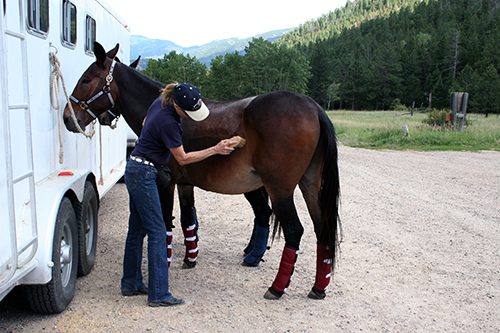 Mules and donkeys, like horses, should be “dressed” for their trip. For their overall comfort during long trips, halters should be fleeced, at least over the noseband, to protect from excessive rubbing that can result from being tied. Shipping wraps for their legs are also advisable to prevent injuries from a loss of balance, misstep or kick from another animal in the trailer. Depending on the weather and the kind of trailer you have (either a stock trailer or enclosed trailer) you can use sheets or blankets to protect the rest of your animal’s body.
Mules and donkeys, like horses, should be “dressed” for their trip. For their overall comfort during long trips, halters should be fleeced, at least over the noseband, to protect from excessive rubbing that can result from being tied. Shipping wraps for their legs are also advisable to prevent injuries from a loss of balance, misstep or kick from another animal in the trailer. Depending on the weather and the kind of trailer you have (either a stock trailer or enclosed trailer) you can use sheets or blankets to protect the rest of your animal’s body.
Donkeys tend to sit back on whatever is behind them while they ride, so they should always wear an oversized sheet or blanket that drops down behind the rump to prevent chafing. If they are not protected in this way, they can develop terrible raw spots on their tails and hindquarters. Using a tail wrap on mules and donkeys is rarely successful, as these tend to slide off (even if they are taped). If they are put on too tightly, they can cut off the circulation in the tail and cause problems.
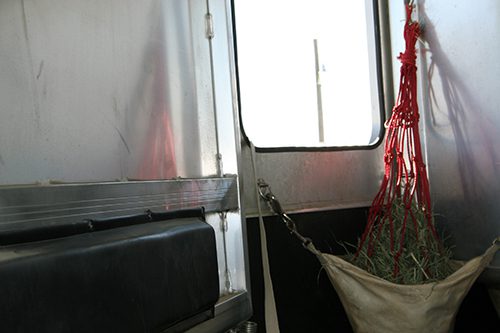 When loading your mules and donkeys, pay special attention to each individual’s needs. Animals that lean one way or the other generally do better in a slant load trailer rather than in an in-line trailer, but if you must use an in-line trailer, make sure that the animal that leans has a solid wall or partition on the side to which he leans. You always want to put animals next to each other that get along well, so if you must load a leaner on the wrong side, be sure to put him next to an animal that is able to tolerate his leaning without retaliating if there are no partitions. If you have an open stock trailer, another alternative is to load your animals into the trailer and tie them facing backwards. Many equines actually prefer to ride facing backwards because they find it easier to balance. Note: This alternative is not advisable in a partitioned in-line or slant-load trailer.
When loading your mules and donkeys, pay special attention to each individual’s needs. Animals that lean one way or the other generally do better in a slant load trailer rather than in an in-line trailer, but if you must use an in-line trailer, make sure that the animal that leans has a solid wall or partition on the side to which he leans. You always want to put animals next to each other that get along well, so if you must load a leaner on the wrong side, be sure to put him next to an animal that is able to tolerate his leaning without retaliating if there are no partitions. If you have an open stock trailer, another alternative is to load your animals into the trailer and tie them facing backwards. Many equines actually prefer to ride facing backwards because they find it easier to balance. Note: This alternative is not advisable in a partitioned in-line or slant-load trailer.
Once on the road, try to keep your equines’ routine as close to their “at home” routine as possible. Keeping grass hay in front of them will help to alleviate some of the stress of the trip, and will encourage them to relax and accept the situation. Feeds such as grain and alfalfa hay should be avoided, since these highly mobilize the intestines and can cause contractions that can lead to colic, particularly if your animals are not drinking enough water along the way. They should at least be offered some water (whether they drink it or not) at every stop you make along the way and ideally, once every two to three hours. Note: Water that your mules and donkeys are not used to may smell or taste strange to them and can be flavored with something they like. For instance, my donkey jack, Little Jack Horner, has a preference for iced tea to flavor unappetizing water on the road. Lightly flavoring your equines’ water may encourage them to continue to eat and drink throughout the trip, and will help keep them happy and healthy. The best idea would be to bring jugs of water from home along with you if at all possible.
If your trailer is large and has good suspension, your mules and donkeys can ride for as long as twelve to fourteen hours without too much discomfort, provided that you make frequent fifteen-to-twenty-minute stops every two to three hours along the journey. This should not interrupt your travel schedule, as you will already be stopping for gas along the way. If your animals are riding in a smaller trailer with more vibration, it is advisable to stop, unload and walk your animals every four to six hours, in order to give them time to stretch, relax and rest their legs. If you have a difficult animal, loading him last is often easiest, since he won’t want to be left behind and will be more likely to follow the other animals into the trailer. This can be inconvenient if you have any animals that are difficult to load because of the extra time involved, but it is always a good opportunity to train them to get in and out of the trailer simply by repetition. By the end of a long trip, they will be loading and unloading much more easily. Just make sure that, if you have equines that are difficult to load, you have allotted yourself enough travel time to include this kind of training.
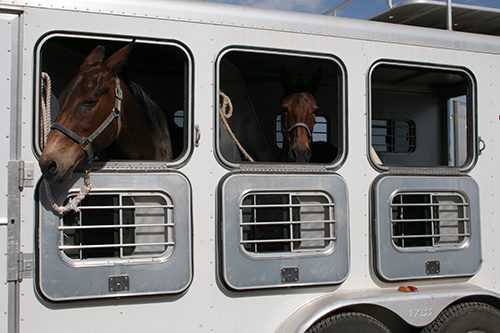 Long before you actually go anywhere, get your animals used to being handled inside the trailer. When unloading, always make them stand and wait. I usually remove my animals’ shipping wraps before I let them come out of the trailer, but if they are packed in pretty tightly, I just remove the leg wraps I can reach. The removal of leg wraps before unloading will add purpose to your Longears’ waiting time (which they quickly come to understand). Frequently offering water at stops gets your animals used to you moving about the trailer while they are loaded. Most equines realize that all of this is for their benefit and you should find them mostly cooperative and appreciative. Having water from home in plastic jugs makes this easy.
Long before you actually go anywhere, get your animals used to being handled inside the trailer. When unloading, always make them stand and wait. I usually remove my animals’ shipping wraps before I let them come out of the trailer, but if they are packed in pretty tightly, I just remove the leg wraps I can reach. The removal of leg wraps before unloading will add purpose to your Longears’ waiting time (which they quickly come to understand). Frequently offering water at stops gets your animals used to you moving about the trailer while they are loaded. Most equines realize that all of this is for their benefit and you should find them mostly cooperative and appreciative. Having water from home in plastic jugs makes this easy.
There are times when weather can change drastically and depending on what the weather and temperatures are doing, your animals may need sheets or blankets either put on or removed. When you teach your animals to stand quietly while you climb around inside the trailer ahead of time, putting on leg wraps or taking them off should help them feel more relaxed and accepting of the whole situation.
When loading or unloading your animals, you must always be very careful not to move too quickly or abruptly, which could possibly startle them and even get you trapped. But if you do have an emergency to attend to en-route, and your animals have been trained in the manner described above, you should be able to get to the animal in trouble with minimal problems. It sometimes takes a little more patience to get horses to stand quietly in the trailer. Once they realize that you are truly concerned with their best interests, mules and donkeys (intelligent creatures that they are), will usually be very cooperative and your long hauls can become relaxing and enjoyable road trips.
To learn more about Meredith Hodges and her comprehensive all-breed equine training program, visit LuckyThreeRanch.com, MEREDITH HODGES PUBLIC FIGURE Facebook page, or call 1-800-816-7566. Check out her children’s website at JasperTheMule.com. Also, find Meredith on Pinterest, Instagram, MeWe, YouTube and Twitter.
© 2000, 2003, 2014, 2016, 2017, 2024 Lucky Three Ranch, Inc. All Rights Reserved.
